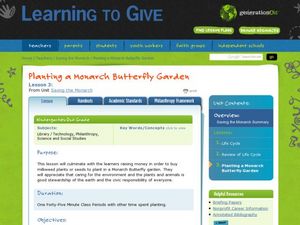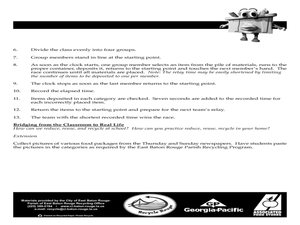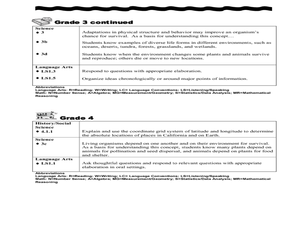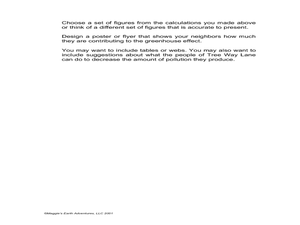Curated OER
Mountain Pine Beetles
High schoolers research and develop power point presentations that answer the question, "What is changing our forests?" In this ecology lesson, students research the niche of Pine Beetles and their increased effect on the forests in...
Curated OER
E-Cycling!
Eighth graders research how and why electronics are recycled. In this earth science lesson, 8th graders determine the types of materials electronic devices are made up of. They produce a creative ad to encourage people to recycle.
Curated OER
Introduction to Coral Reefs
Young scholars identify locations of coral reefs, both in the water and around the globe, identify relative depth of corals in the ocean by observing behavior of cold and warm saltwater, and create models of coral reefs.
Curated OER
Oil on the Beach
Students explore how oil pollutes the oceans. In this science lesson, students investigate various materials that could be used to clean up an oil spill. Students discuss which materials worked best and how humans can reduce oil spills.
Curated OER
Planting a Monarch Butterfly Garden
Students raise money to purchase milkweed plants for their butterfly garden. In this gardening lesson, students listen to the story Miss Rumphius to determine why it is important to plant milkweed for butterflies. Students develop a...
Curated OER
What Makes you Hot?
Students manipulate different variables in a model and make inferences about the temperature on Earth. In this heat lesson students calculate the blackbody radiation of an object at a certain temperature.
Curated OER
Dunk It! Don't Junk It!
Third graders explore the concept of sorting recyclables. In this recycling lesson plan, 3rd graders determine how to separate recyclables from waste and how to sort recyclables into different categories.
Curated OER
Global Environmental Change
Students examine environmental change of land, water, and air, discuss Clear Skies Legislation, and experiment on solid compaction and
resultant water filtration.
Curated OER
Informational Reading: Electronics Are Made from Resources
For this comprehension worksheet, students read about the making of a computer: circuit boards, hard drives, monitors and plastic housings. Students then answer 3 multiples choice questions.
Curated OER
Technology has a Solution!
In this technology worksheet, students summarize four things they learned about technology and the environment. Students then write a report that outlines how technology is solving environmental issues.
Curated OER
Designing More Effective Packages
Students make an environmentally sound package. In this packaging lesson students examine various types of modern packaging. The problem of waste is discussed leading into a discussion of waste reduction. The students choose an item that...
Curated OER
Earth Pockets
Students identify the Earth's natural resources. In this Earth science lesson, students read the book The Great Kapok Tree and discuss types of natural resources. Students use categories such as wood, paper, and trees and list items that...
Curated OER
How Big is Your Footprint?
Young scholars create awareness for ways in which the "Western" lifestyle negatively impacts the Earth. They create awareness for alternatives to our current ways of living, eating and traveling. Students are challenged to talk with...
Curated OER
Hometown Ecology
Students examine how ecology is at work in their own community. As a class, they identify what they already know about the world around them and discuss how they personally affect the environment. Using magazines, newspapers and the...
Curated OER
Carlyle Figures It Out
In this money worksheet, students read a passage titled Carlyle Figures It Out and completes word problems about it. Students complete 2 word problems and answer 2 opinion questions.
Curated OER
Lesson- Infinite Potential Well
Student create a numerical model which integrates Schrodinger's equation in 1 dimension. They discuss the properties of the solutions which match the boundary conditions. Student discusss any limitations if there are any in there model.
Curated OER
Kepler's Second Law
Students explore orbital velocities and how they vary along each orbit, according to Kepler's Second Law.
Curated OER
When the Lights Go Out!
Students identify coal as the primary fuel used to generate electricity. After discussing coal's use in the generation of electricity, have students complete "When the Light Go Out" worksheet.
Curated OER
How Electronics Come to Us: Distribution and Use
Students identify environmental challenges that can be solved throughout a product's life cycle. They experiment and examine how we can choose and use products in an environmentally responsible manner. Each student is also involved in...
Unite for Literacy
Unite for Literacy: Energy Conservation: Electricity
Read about where how the electricity to our homes is produced and why it is important to conserve energy. Book includes audio narration in nine additional languages with text in English.
State Energy Conservation Office-Texas
State Energy Conservation Office: Energy Conservation in the Home [Pdf]
Looks at how energy is used in a home, and strategies in construction, choice of appliances, etc. for minimizing waste.
State Energy Conservation Office-Texas
State Energy Conservation Office: Renewable Energy for the Home [Pdf]
Discusses different ways to heat and cool a home, and perform a variety of tasks, using renewable energy sources. Examples include window shades, a solar water heater, solar-powered toys, etc.
State Energy Conservation Office-Texas
State Energy Conservation Office: Passive Solar Design for Homes [Pdf]
Discusses different features that can be incorporated into a home's design in order to harness solar energy.
Other
Alliance to Save Energy: A Home Energy Audit
This activity allows students to become building inspectors, identifying features that can help or hurt energy conservation.




















![State Energy Conservation Office: Energy Conservation in the Home [Pdf] Handout State Energy Conservation Office: Energy Conservation in the Home [Pdf] Handout](https://d15y2dacu3jp90.cloudfront.net/images/attachment_defaults/resource/large/FPO-knovation.png)